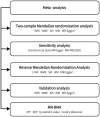Investigating the causal association between gut microbiota and type 2 diabetes: a meta-analysis and Mendelian randomization
- PMID: 38962766
- PMCID: PMC11220316
- DOI: 10.3389/fpubh.2024.1342313
Investigating the causal association between gut microbiota and type 2 diabetes: a meta-analysis and Mendelian randomization
Abstract
Background: Studies have shown that gut dysbiosis contributes to the pathophysiology of type 2 diabetes mellitus (T2DM). Identifying specific gut microbiota dysbiosis may provide insight into the pathogenesis of T2DM.
Purpose: This study investigated the causal relationship between gut microbiota and T2DM using meta-analysis and Mendelian randomization (MR).
Methods: In the first part, we searched for literature on gut microbiota and T2DM, and conducted a meta-analysis. We observed differences in glycosylated hemoglobin and fasting blood glucose levels in both groups. Second, we obtained GWAS data from genome-wide association study database 19 (GWAS). We used two-sample MR analysis to verify the forward and reverse causal associations between gut microbiota and T2DM. Additionally, we selected the European GWAS data from the European Bioinformatics Institute (EBI) as a validation set for external validation of the MR analysis. In the third part, we aimed to clarify which gut microbiota contribute to the degree of causal association between group disorders and T2DM through multivariate MR analysis and Bayesian model averaging (MR-BMA).
Results: 1. According to the meta-analysis results, the glycated hemoglobin concentration in the gut probiotic intervention group was significantly lower than in the control group. Following treatment, fasting blood glucose levels in the intervention group were significantly lower than those in the control group. 2. The results of two samples MR analysis revealed that there were causal relationships between six gut microbiota and T2DM. Genus Haemophilus and order Pasteurellaceae were negatively correlated with T2DM. Genus Actinomycetes, class Melanobacteria and genus Lactobacillus were positively correlated. Reverse MR analysis demonstrated that T2DM and gut microbiota did not have any reverse causal relationship. The external validation data set showed a causal relationship between gut microbiota and T2DM. 3. Multivariate MR analysis and MR-BMA results showed that the independent genus Haemophilus collection had the largest PP.
Conclusion: Our research results suggest that gut microbiota is closely related to T2DM pathogenesis. The results of further MR research and an analysis of the prediction model indicate that a variety of gut microbiota disorders, including genus Haemophilus, are causally related to the development of T2DM. The findings of this study may provide some insight into the diagnosis and treatment of T2DM.
Systematic review registration: https://www.crd.york.ac.uk/PROSPERO.
Keywords: MR-BMA; MR-BMA gut microbiota; T2DM; meta-analysis; multi-sample MR analysis; two-sample MR analysis.
Copyright © 2024 Liu, Cao, Liang, Ma, Fang and Zhang.
Conflict of interest statement
The authors declare that the research was conducted in the absence of any commercial or financial relationships that could be construed as a potential conflict of interest.
Figures







Similar articles
-
Genetic associations between gut microbiota and type 2 diabetes mediated by plasma metabolites: a Mendelian randomization study.Front Endocrinol (Lausanne). 2024 Aug 9;15:1430675. doi: 10.3389/fendo.2024.1430675. eCollection 2024. Front Endocrinol (Lausanne). 2024. PMID: 39184139 Free PMC article.
-
The causal relationship between gut microbiota and type 2 diabetes: a two-sample Mendelian randomized study.Front Public Health. 2023 Sep 22;11:1255059. doi: 10.3389/fpubh.2023.1255059. eCollection 2023. Front Public Health. 2023. PMID: 37808975 Free PMC article. Clinical Trial.
-
Causal associations between gut microbiota and type 2 diabetes mellitus subtypes: a mendelian randomization analysis.BMC Endocr Disord. 2025 Mar 24;25(1):79. doi: 10.1186/s12902-025-01863-x. BMC Endocr Disord. 2025. PMID: 40122799 Free PMC article.
-
Exploring the potential causal relationship between gut microbiota and heart failure: A two-sample mendelian randomization study combined with the geo database.Curr Probl Cardiol. 2024 Feb;49(2):102235. doi: 10.1016/j.cpcardiol.2023.102235. Epub 2023 Nov 30. Curr Probl Cardiol. 2024. PMID: 38040216 Review.
-
Effect of probiotics at different intervention time on glycemic control in patients with type 2 diabetes mellitus: a systematic review and meta-analysis.Front Endocrinol (Lausanne). 2024 Jul 24;15:1392306. doi: 10.3389/fendo.2024.1392306. eCollection 2024. Front Endocrinol (Lausanne). 2024. PMID: 39114293 Free PMC article.
Cited by
-
The aging choroid plexus and its relationship with gut dysbiosis and Klotho decline: possible intervention strategies.Geroscience. 2025 Jul 22. doi: 10.1007/s11357-025-01797-1. Online ahead of print. Geroscience. 2025. PMID: 40691670 Review.
-
Comparison of Glucose Metabolizing Properties of Enterobacterial Probiotic Strains In Vitro.Nutrients. 2024 Aug 13;16(16):2677. doi: 10.3390/nu16162677. Nutrients. 2024. PMID: 39203813 Free PMC article.
-
A Meta-Analysis of the Human Gut Mycobiome Using Internal Transcribed Spacer Data.Microorganisms. 2024 Dec 13;12(12):2567. doi: 10.3390/microorganisms12122567. Microorganisms. 2024. PMID: 39770770 Free PMC article.
References
-
- Hasanian-Langroudi F, Ghasemi A, Hedayati M, Siadat SD, Tohidi M. Novel insight into the effect of probiotics in the regulation of the most important pathways involved in the pathogenesis of type 2 diabetes mellitus. Probiot Antimicrob Proteins. (2023) 16:829–844. 10.1007/s12602-023-10056-8 - DOI - PubMed
Publication types
MeSH terms
Substances
LinkOut - more resources
Full Text Sources
Medical
Miscellaneous

